6
May 2020
PDF version [929 KB]
Gregory
O'Brien
Statistics and
Mapping
Contents
Executive summary
Introduction
Chapter 1: Labour
Market
1.1 Employment
1.3 Labour force
1.4 Youth
unemployment
1.5 Underemployment
Chapter 2: Wages and
Prices
2.1 Average weekly
ordinary time earnings
2.2 Real average
weekly ordinary time earnings
2.3 Male total
average weekly earnings
2.4 Female total
average weekly earnings
2.5 Wage price index
2.6 Consumer price
index
Chapter 3: State
Accounts
3.1 Gross state
product
3.2 Gross state
product per capita
3.3 Labour
productivity
Chapter 4: Business
Conditions
4.1 Value of retail
sales
4.2 Dwelling
approvals
4.3 Business
investment
Chapter 5: Housing
5.1 Lending for owner
occupied housing
Chapter 6: Public
Sector Finances
6.1 General
government sector fiscal balance
6.2 State and local
government taxation revenue
Chapter 7: Exports
7.1 Merchandise
exports
Chapter 8: Social
Statistics
8.1 Population
8.2 Capped apparent
school retention rates
8.3 General practice
bulk billing
Glossary
Executive summary
- This paper, a companion to the Monthly
Statistical Bulletin published by the Parliamentary Library, provides tables
and charts for a broad range of social, demographic and economic indicators
across all Australian states and territories, and compares these with Australian
averages.
- Each table presents data for the past five
calendar years to 2019, where available, while each chart plots data for the
calendar year 2019.
- The State Statistical Bulletin is published
twice per year covering data for both the previous financial year and calendar
year.
Introduction
The purpose of this paper is to present a range
of economic and other statistical indicators for the states and territories of
Australia. To facilitate comparisons, indicators are presented in relative
terms such as growth rates, percentages, or proportions of gross state product,
so comparisons can be made using equivalent measures.
This publication is a companion to the Monthly
Statistical Bulletin which contains
Australia-wide data only, but on a more frequent basis.
A glossary of social, demographic and economic terms used in the
tables is provided at the end of this publication.
Data
Sources
Data sources are listed at the bottom of the page for each
indicator. All data is from an original ABS series unless otherwise indicated
as a trend or seasonally adjusted series.
Historical
Data
Long-term data series for
every table in this paper and for the Parliamentary Library’s companion
publication, the Monthly
Statistical Bulletin, are available
electronically and can be found on the Parliamentary Library’s Monthly
Statistical Bulletin and State Statistical
Bulletin pages.
Chapter 1: Labour Market
1.1 Employment
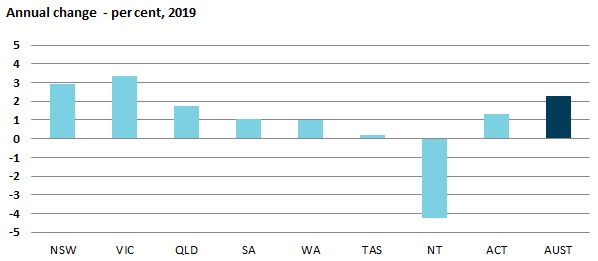
| |
2015 |
2016 |
2017 |
2018 |
2019 |
| |
|
|
|
|
|
| Number employed (a) – '000 |
|
|
|
|
| New South Wales |
3 714.9 |
3 811.4 |
3 875.1 |
4 010.0 |
4 126.3 |
| Victoria |
2 994.4 |
3 096.0 |
3 205.8 |
3 293.1 |
3 404.1 |
| Queensland |
2 343.5 |
2 358.3 |
2 417.2 |
2 484.4 |
2 527.3 |
| South Australia |
804.0 |
812.2 |
825.0 |
842.8 |
851.8 |
| Western Australia |
1 321.9 |
1 303.7 |
1 320.4 |
1 339.6 |
1 352.7 |
| Tasmania |
240.2 |
237.8 |
245.7 |
249.4 |
249.9 |
| Northern Territory |
134.8 |
135.7 |
138.2 |
136.6 |
130.8 |
| Australian Capital Territory |
212.5 |
218.0 |
224.7 |
228.2 |
231.2 |
| Australia |
11 766.3 |
11 973.1 |
12 252.0 |
12 584.1 |
12 874.0 |
| |
|
|
|
|
|
| Annual change – per cent |
|
|
|
|
|
| New South Wales |
2.7 |
2.6 |
1.7 |
3.5 |
2.9 |
| Victoria |
3.1 |
3.4 |
3.5 |
2.7 |
3.4 |
| Queensland |
0.9 |
0.6 |
2.5 |
2.8 |
1.7 |
| South Australia |
0.3 |
1.0 |
1.6 |
2.2 |
1.1 |
| Western Australia |
0.7 |
-1.4 |
1.3 |
1.5 |
1.0 |
| Tasmania |
1.1 |
-1.0 |
3.3 |
1.5 |
0.2 |
| Northern Territory |
2.5 |
0.6 |
1.9 |
-1.2 |
-4.3 |
| Australian Capital Territory |
0.3 |
2.6 |
3.0 |
1.6 |
1.3 |
| Australia |
2.0 |
1.8 |
2.3 |
2.7 |
2.3 |
| |
|
|
|
|
|
| |
|
|
|
|
|
| (a)
Total full-time and part-time employed; Annual average of monthly data. |
| Source:
ABS, Labour Force, cat. no. 6291.0.55.001, February 2020 |
1.2 Unemployment
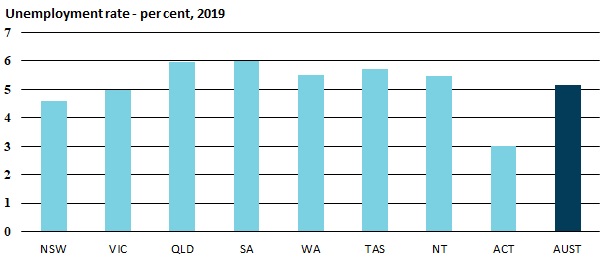
| |
2015 |
2016 |
2017 |
2018 |
2019 |
| |
|
|
|
|
|
| Number unemployed (a) – '000 |
|
|
|
|
| New South Wales |
226.7 |
205.7 |
196.6 |
198.1 |
192.5 |
| Victoria |
194.8 |
191.7 |
203.0 |
172.7 |
169.1 |
| Queensland |
156.6 |
153.3 |
156.8 |
163.3 |
165.5 |
| South Australia |
64.3 |
59.5 |
55.8 |
50.8 |
56.7 |
| Western Australia |
82.5 |
84.2 |
83.0 |
88.7 |
84.9 |
| Tasmania |
16.8 |
16.5 |
15.4 |
15.6 |
16.9 |
| Northern Territory |
5.9 |
5.3 |
5.6 |
6.1 |
6.9 |
| Australian Capital Territory |
10.6 |
8.9 |
9.4 |
8.7 |
8.2 |
| Australia |
758.3 |
725.1 |
725.6 |
704.0 |
700.8 |
| |
|
|
|
|
|
| Unemployment rate (b) – per cent |
|
|
|
|
| New South Wales |
5.3 |
5.1 |
4.8 |
4.3 |
4.6 |
| Victoria |
6.0 |
5.9 |
5.7 |
4.6 |
5.0 |
| Queensland |
6.0 |
6.2 |
6.0 |
6.1 |
6.0 |
| South Australia |
7.1 |
6.6 |
6.0 |
5.9 |
6.0 |
| Western Australia |
6.0 |
6.4 |
6.0 |
6.3 |
5.5 |
| Tasmania |
6.6 |
6.0 |
6.0 |
6.3 |
5.7 |
| Northern Territory |
4.2 |
3.3 |
4.2 |
4.6 |
5.5 |
| Australian Capital Territory |
4.8 |
3.7 |
3.9 |
3.6 |
3.0 |
| Australia |
5.8 |
5.8 |
5.5 |
5.0 |
5.1 |
| |
|
|
|
|
|
| |
|
|
|
|
|
| (a) Annual average of monthly data. |
|
|
|
|
| (b) Number unemployed as a proportion of the labour force, trend
terms, as at December. |
|
| Source:
ABS, Labour Force, cat. no. 6202.0, February 2020 |
1.3 Labour force
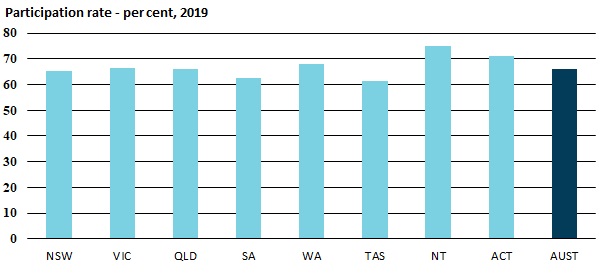
| |
2015 |
2016 |
2017 |
2018 |
2019 |
| |
|
|
|
|
|
| Labour force (a) – '000 |
|
|
|
|
|
| New South Wales |
3 941.6 |
4 017.1 |
4 071.7 |
4 208.1 |
4 318.8 |
| Victoria |
3 189.3 |
3 287.7 |
3 408.8 |
3 465.8 |
3 573.2 |
| Queensland |
2 500.1 |
2 511.6 |
2 573.9 |
2 647.7 |
2 692.8 |
| South Australia |
868.3 |
871.7 |
880.8 |
893.5 |
908.5 |
| Western Australia |
1 404.4 |
1 387.8 |
1 403.4 |
1 428.3 |
1 437.6 |
| Tasmania |
257.0 |
254.3 |
261.1 |
265.0 |
266.8 |
| Northern Territory |
140.8 |
141.0 |
143.8 |
142.7 |
137.7 |
| Australian Capital Territory |
223.1 |
226.9 |
234.0 |
236.9 |
239.4 |
| Australia |
12 524.5 |
12 698.1 |
12 977.6 |
13 288.1 |
13 574.8 |
| |
|
|
|
|
|
| Participation rate (b) – per cent |
|
|
|
|
| New South Wales |
64.4 |
63.5 |
64.5 |
65.0 |
65.4 |
| Victoria |
64.9 |
65.7 |
66.0 |
65.9 |
66.5 |
| Queensland |
65.8 |
64.2 |
66.0 |
65.6 |
65.9 |
| South Australia |
62.1 |
62.2 |
62.5 |
62.8 |
62.5 |
| Western Australia |
68.3 |
67.2 |
68.2 |
68.4 |
68.2 |
| Tasmania |
60.6 |
59.8 |
61.2 |
60.5 |
61.3 |
| Northern Territory |
74.8 |
77.1 |
75.7 |
73.8 |
74.9 |
| Australian Capital Territory |
70.5 |
70.3 |
72.5 |
69.6 |
70.9 |
| Australia |
65.2 |
64.7 |
65.6 |
65.6 |
66.0 |
| |
|
|
|
|
|
| |
|
|
|
|
|
| (a) Annual average of monthly data. |
|
|
|
|
| (b) Labour force as a proportion of the civilian population aged
15 years and over, trend series, as at December |
| Source:
ABS, Labour Force, cat. no. 6202.0, February 2020 |
1.4 Youth unemployment
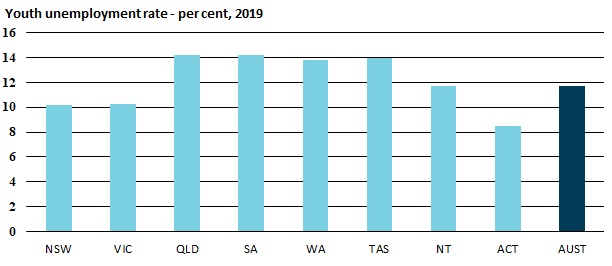
| |
2015 |
2016 |
2017 |
2018 |
2019 |
| |
|
|
|
|
|
| Number unemployed (a) – '000 |
|
|
|
|
| New South Wales |
80.2 |
76.6 |
72.6 |
71.1 |
70.6 |
| Victoria |
76.9 |
70.6 |
71.6 |
63.3 |
59.2 |
| Queensland |
59.1 |
59.8 |
60.1 |
60.1 |
66.6 |
| South Australia |
22.9 |
20.7 |
22.9 |
18.6 |
21.3 |
| Western Australia |
24.5 |
26.9 |
29.8 |
32.3 |
30.3 |
| Tasmania |
6.7 |
6.9 |
6.0 |
6.5 |
6.1 |
| Northern Territory |
2.2 |
1.6 |
1.9 |
2.2 |
2.2 |
| Australian Capital Territory |
4.2 |
3.7 |
4.1 |
3.4 |
3.5 |
| Australia |
276.6 |
266.8 |
268.8 |
257.5 |
259.8 |
| |
|
|
|
|
|
| Youth unemployment rate (b) – per cent |
|
|
|
|
| New South Wales |
12.3 |
11.7 |
11.0 |
10.3 |
10.1 |
| Victoria |
14.5 |
13.0 |
13.0 |
11.4 |
10.3 |
| Queensland |
13.1 |
13.5 |
13.1 |
12.8 |
14.2 |
| South Australia |
15.6 |
14.6 |
16.0 |
12.6 |
14.2 |
| Western Australia |
10.7 |
11.8 |
13.6 |
14.5 |
13.8 |
| Tasmania |
15.3 |
16.1 |
13.7 |
15.1 |
14.0 |
| Northern Territory |
9.5 |
7.3 |
8.7 |
10.8 |
11.7 |
| Australian Capital Territory |
12.0 |
9.9 |
10.5 |
8.9 |
8.5 |
| Australia |
13.1 |
12.6 |
12.6 |
11.8 |
11.7 |
| |
|
|
|
|
|
| |
|
|
|
|
|
| (a) 15-24 year olds, annual average of monthly data. |
| (b) 15-24 year olds, annual average of monthly rates, original
terms. |
| Source:
ABS, Labour Force, cat. no. 6202.0, February 2020 |
1.5
Underemployment
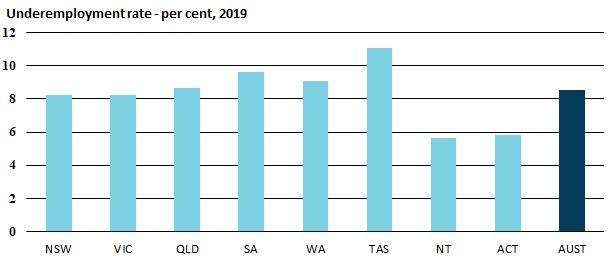
| |
2015 |
2016 |
2017 |
2018 |
2019 |
| |
|
|
|
|
|
| Number underemployed (a) – '000 |
|
|
|
|
| New South Wales |
314.0 |
318.4 |
324.0 |
333.4 |
334.1 |
| Victoria |
283.7 |
299.2 |
293.4 |
279.2 |
296.7 |
| Queensland |
214.9 |
208.0 |
221.7 |
235.8 |
230.4 |
| South Australia |
83.9 |
87.6 |
85.2 |
85.1 |
82.1 |
| Western Australia |
111.5 |
126.5 |
137.3 |
132.9 |
131.6 |
| Tasmania |
26.4 |
23.7 |
26.6 |
26.2 |
27.9 |
| Northern Territory |
6.6 |
7.0 |
7.1 |
6.1 |
7.8 |
| Australian Capital Territory |
14.9 |
13.3 |
14.5 |
14.8 |
14.0 |
| Australia |
1 055.8 |
1 083.7 |
1 109.7 |
1 113.5 |
1 124.7 |
| |
|
|
|
|
|
| Underemployment rate (b) – per cent |
|
|
|
|
| New South Wales |
7.7 |
8.0 |
8.3 |
7.7 |
8.2 |
| Victoria |
9.1 |
9.2 |
8.4 |
8.1 |
8.3 |
| Queensland |
8.5 |
8.5 |
8.8 |
8.8 |
8.6 |
| South Australia |
10.4 |
10.0 |
9.3 |
9.1 |
9.6 |
| Western Australia |
8.9 |
9.6 |
9.2 |
9.2 |
9.1 |
| Tasmania |
9.9 |
9.6 |
10.5 |
10.1 |
11.0 |
| Northern Territory |
5.1 |
5.2 |
4.6 |
4.9 |
5.6 |
| Australian Capital Territory |
6.5 |
5.8 |
5.7 |
6.3 |
5.8 |
| Australia |
8.5 |
8.7 |
8.5 |
8.3 |
8.5 |
| |
|
|
|
|
|
| |
|
|
|
|
|
| (a) Annual average of monthly data. |
|
|
|
|
| (b) Number underemployed as a proportion of the labour force,
trend terms, as at December. |
|
| Source:
ABS, Labour Force, cat. no. 6202.0, February 2020 |
Chapter 2: Wages and Prices
2.1 Average weekly ordinary time
earnings
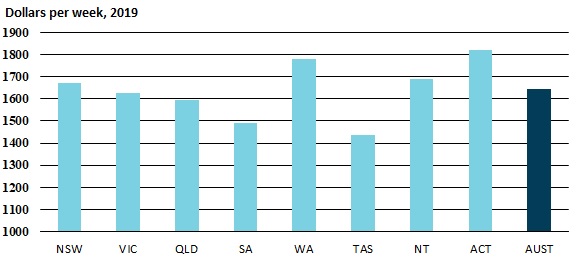
| |
2015 |
2016 |
2017 |
2018 |
2019 |
| |
|
|
|
|
|
| AWOTE (a) (b) – $ per week |
|
|
|
|
| New South Wales |
1 519.7 |
1 538.4 |
1 565.9 |
1 614.1 |
1 672.2 |
| Victoria |
1 410.7 |
1 477.3 |
1 516.0 |
1 557.1 |
1 627.5 |
| Queensland |
1 443.8 |
1 471.2 |
1 512.0 |
1 558.0 |
1 593.3 |
| South Australia |
1 362.1 |
1 430.5 |
1 444.6 |
1 455.4 |
1 489.5 |
| Western Australia |
1 700.0 |
1 700.9 |
1 728.8 |
1 748.7 |
1 779.3 |
| Tasmania |
1 303.9 |
1 339.9 |
1 354.5 |
1 389.4 |
1 435.2 |
| Northern Territory |
1 533.3 |
1 604.1 |
1 632.2 |
1 655.9 |
1 687.7 |
| Australian Capital Territory |
1 711.3 |
1 736.2 |
1 788.6 |
1 811.7 |
1 819.8 |
| Australia |
1 491.8 |
1 524.7 |
1 556.4 |
1 595.4 |
1 646.6 |
| |
|
|
|
|
|
| Annual change – per cent |
|
|
|
|
|
| New South Wales |
3.0 |
1.2 |
1.8 |
3.1 |
3.6 |
| Victoria |
1.6 |
4.7 |
2.6 |
2.7 |
4.5 |
| Queensland |
-0.3 |
1.9 |
2.8 |
3.0 |
2.3 |
| South Australia |
0.7 |
5.0 |
1.0 |
0.8 |
2.3 |
| Western Australia |
2.6 |
0.1 |
1.6 |
1.2 |
1.7 |
| Tasmania |
3.7 |
2.8 |
1.1 |
2.6 |
3.3 |
| Northern Territory |
6.8 |
4.6 |
1.8 |
1.5 |
1.9 |
| Australian Capital Territory |
1.7 |
1.5 |
3.0 |
1.3 |
0.4 |
| Australia |
1.8 |
2.2 |
2.1 |
2.5 |
3.2 |
| |
|
|
|
|
|
| |
| (a) Annual average of bi-annual data. |
| (b) Average weekly ordinary time earnings for full-time adult
employees. |
| Care should be taken when comparing average weekly earnings of
states over time due to compositional changes. |
| Source:
ABS, Average Weekly Earnings, cat. no.6302.0, November 2019 |
2.2
Real average weekly ordinary time earnings
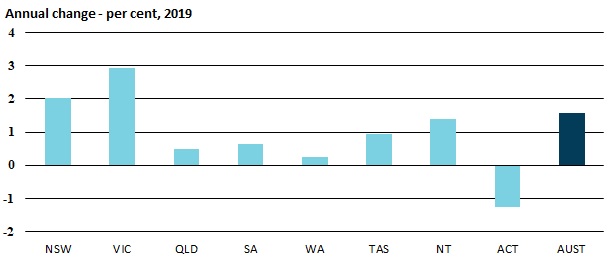
| |
2015 |
2016 |
2017 |
2018 |
2019 |
| |
|
|
|
|
|
| Real AWOTE (a) (b) – $ per week |
|
|
|
|
| New South Wales |
1 630.2 |
1 627.0 |
1 621.0 |
1 639.1 |
1 672.2 |
| Victoria |
1 520.4 |
1 568.8 |
1 574.2 |
1 581.3 |
1 627.5 |
| Queensland |
1 544.4 |
1 549.6 |
1 564.6 |
1 585.5 |
1 593.3 |
| South Australia |
1 455.1 |
1 513.6 |
1 499.7 |
1 480.0 |
1 489.5 |
| Western Australia |
1 768.5 |
1 760.5 |
1 774.2 |
1 774.8 |
1 779.3 |
| Tasmania |
1 416.5 |
1 437.0 |
1 421.4 |
1 421.9 |
1 435.2 |
| Northern Territory |
1 567.1 |
1 642.2 |
1 660.3 |
1 664.5 |
1 687.7 |
| Australian Capital Territory |
1 846.6 |
1 850.6 |
1 865.9 |
1 843.2 |
1 819.8 |
| Australia |
1 595.0 |
1 609.6 |
1 611.7 |
1 621.1 |
1 646.6 |
| |
|
|
|
|
|
| Annual change – per cent |
|
|
|
|
|
| New South Wales |
1.1 |
-0.2 |
-0.4 |
1.1 |
2.0 |
| Victoria |
0.2 |
3.2 |
0.3 |
0.5 |
2.9 |
| Queensland |
-1.8 |
0.3 |
1.0 |
1.3 |
0.5 |
| South Australia |
-0.4 |
4.0 |
-0.9 |
-1.3 |
0.6 |
| Western Australia |
1.3 |
-0.5 |
0.8 |
0.0 |
0.3 |
| Tasmania |
2.6 |
1.4 |
-1.1 |
0.0 |
0.9 |
| Northern Territory |
6.3 |
4.8 |
1.1 |
0.3 |
1.4 |
| Australian Capital Territory |
1.0 |
0.2 |
0.8 |
-1.2 |
-1.3 |
| Australia |
0.3 |
0.9 |
0.1 |
0.6 |
1.6 |
| |
|
|
|
|
|
| |
|
|
|
|
|
| (a) Annual average. |
|
|
|
|
|
| (b) Average weekly ordinary time earnings for full-time adult
employees expressed in average 2019 dollars; converted to real terms using
the Consumer Price Index. |
| Care should be taken when comparing average weekly earnings of
states over time due to compositional changes. |
| Sources:
ABS, Average Weekly Earnings, cat. no. 6302.0, Nov 2019; ABS, Consumer
Price Index, cat. no. 6401.0, Dec 2019 |
2.3 Male total average weekly
earnings
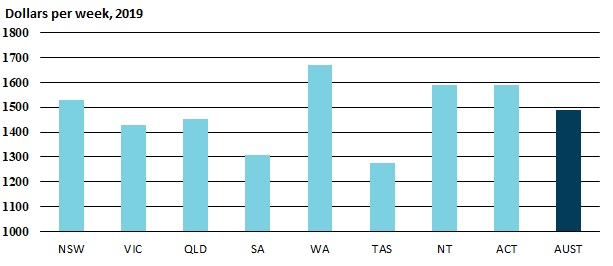
| |
2015 |
2016 |
2017 |
2018 |
2019 |
| |
|
|
|
|
|
| MTAWE (a) (b) – $ per week |
|
|
|
|
| New South Wales |
1 388.8 |
1 421.9 |
1 443.8 |
1 466.9 |
1 528.2 |
| Victoria |
1 278.1 |
1 314.2 |
1 344.5 |
1 393.9 |
1 428.8 |
| Queensland |
1 323.7 |
1 354.8 |
1 396.3 |
1 450.7 |
1 452.9 |
| South Australia |
1 241.0 |
1 267.9 |
1 285.9 |
1 265.8 |
1 307.7 |
| Western Australia |
1 657.8 |
1 636.5 |
1 645.9 |
1 641.9 |
1 667.8 |
| Tasmania |
1 163.2 |
1 163.3 |
1 227.5 |
1 258.9 |
1 274.4 |
| Northern Territory |
1 508.5 |
1 650.2 |
1 683.4 |
1 613.6 |
1 590.6 |
| Australian Capital Territory |
1 530.4 |
1 513.4 |
1 570.8 |
1 661.2 |
1 590.2 |
| Australia |
1 372.2 |
1 396.5 |
1 422.5 |
1 452.9 |
1 486.9 |
| |
|
|
|
|
|
| Annual change – per cent |
|
|
|
|
|
| New South Wales |
3.0 |
2.4 |
1.5 |
1.6 |
4.2 |
| Victoria |
0.1 |
2.8 |
2.3 |
3.7 |
2.5 |
| Queensland |
-2.2 |
2.3 |
3.1 |
3.9 |
0.2 |
| South Australia |
-3.1 |
2.2 |
1.4 |
-1.6 |
3.3 |
| Western Australia |
-0.3 |
-1.3 |
0.6 |
-0.2 |
1.6 |
| Tasmania |
2.8 |
0.0 |
5.5 |
2.6 |
1.2 |
| Northern Territory |
5.0 |
9.4 |
2.0 |
-4.1 |
-1.4 |
| Australian Capital Territory |
1.3 |
-1.1 |
3.8 |
5.8 |
-4.3 |
| Australia |
0.3 |
1.8 |
1.9 |
2.1 |
2.3 |
| |
|
|
|
|
|
| |
|
|
|
|
|
| (a) Annual average of bi-annual data. |
|
|
|
|
| (b) Total average weekly earnings for all male employees. Not
adjusted for CPI. |
| Source:
ABS, Average Weekly Earnings, cat. no. 6302.0, November 2019 |
2.4 Female total average weekly
earnings
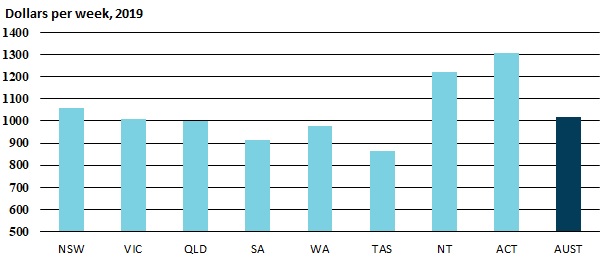
| |
2015 |
2016 |
2017 |
2018 |
2019 |
| |
|
|
|
|
|
| FTAWE (a) (b) – $ per week |
|
|
|
|
| New South Wales |
940.1 |
970.7 |
996.3 |
1 041.9 |
1 057.8 |
| Victoria |
867.3 |
892.3 |
934.0 |
963.8 |
1 010.0 |
| Queensland |
897.5 |
894.0 |
894.9 |
940.5 |
1 000.8 |
| South Australia |
836.5 |
844.7 |
879.9 |
897.2 |
911.6 |
| Western Australia |
959.7 |
963.6 |
976.7 |
966.8 |
975.3 |
| Tasmania |
778.1 |
786.2 |
827.2 |
849.6 |
865.2 |
| Northern Territory |
1 048.5 |
1 097.9 |
1 143.5 |
1 160.4 |
1 221.7 |
| Australian Capital Territory |
1 206.1 |
1 217.5 |
1 225.8 |
1 259.7 |
1 306.1 |
| Australia |
911.3 |
929.1 |
953.2 |
986.3 |
1 019.3 |
| |
|
|
|
|
|
| Annual change – per cent |
|
|
|
|
|
| New South Wales |
3.9 |
3.3 |
2.6 |
4.6 |
1.5 |
| Victoria |
2.9 |
2.9 |
4.7 |
3.2 |
4.8 |
| Queensland |
5.0 |
-0.4 |
0.1 |
5.1 |
6.4 |
| South Australia |
-2.3 |
1.0 |
4.2 |
2.0 |
1.6 |
| Western Australia |
1.7 |
0.4 |
1.4 |
-1.0 |
0.9 |
| Tasmania |
0.9 |
1.0 |
5.2 |
2.7 |
1.8 |
| Northern Territory |
4.2 |
4.7 |
4.2 |
1.5 |
5.3 |
| Australian Capital Territory |
3.9 |
0.9 |
0.7 |
2.8 |
3.7 |
| Australia |
3.0 |
2.0 |
2.6 |
3.5 |
3.3 |
| |
|
|
|
|
|
| |
|
|
|
|
|
| (a) Annual average of bi-annual data. |
|
|
|
|
| (b) Total average weekly earnings for all female employees. Not
adjusted for CPI. |
| Source: ABS, Average Weekly Earnings, cat. no. 6302.0,
November 2019 |
2.5
Wage price index
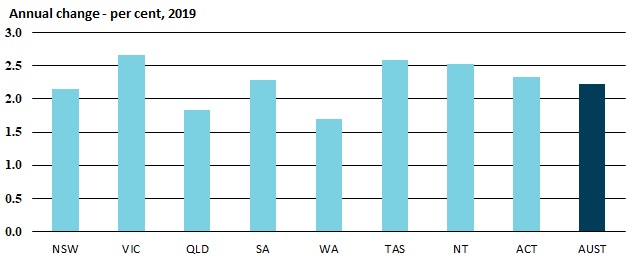
| |
2015 |
2016 |
2017 |
2018 |
2019 |
| |
|
|
|
|
|
| Wage price index (a) (b) |
|
|
|
|
|
| New South Wales |
122.1 |
124.7 |
127.2 |
130.3 |
133.1 |
| Victoria |
122.9 |
125.2 |
128.2 |
131.6 |
135.1 |
| Queensland |
122.6 |
125.0 |
127.7 |
130.6 |
133.0 |
| South Australia |
123.0 |
125.7 |
128.1 |
131.1 |
134.1 |
| Western Australia |
124.5 |
126.2 |
128.1 |
130.1 |
132.3 |
| Tasmania |
122.2 |
125.1 |
127.9 |
131.2 |
134.6 |
| Northern Territory |
124.0 |
126.6 |
128.0 |
130.8 |
134.1 |
| Australian Capital Territory |
121.4 |
123.7 |
126.1 |
128.6 |
131.6 |
| Australia |
122.7 |
125.1 |
127.7 |
130.6 |
133.5 |
| |
|
|
|
|
|
| Annual change – per cent |
|
|
|
|
|
| New South Wales |
2.1 |
2.1 |
2.0 |
2.4 |
2.1 |
| Victoria |
2.4 |
1.9 |
2.4 |
2.7 |
2.7 |
| Queensland |
1.9 |
2.0 |
2.2 |
2.3 |
1.8 |
| South Australia |
2.3 |
2.2 |
1.9 |
2.3 |
2.3 |
| Western Australia |
1.8 |
1.4 |
1.5 |
1.6 |
1.7 |
| Tasmania |
2.2 |
2.4 |
2.2 |
2.6 |
2.6 |
| Northern Territory |
2.4 |
2.1 |
1.1 |
2.2 |
2.5 |
| Australian Capital Territory |
1.6 |
1.9 |
1.9 |
2.0 |
2.3 |
| Australia |
2.1 |
2.0 |
2.1 |
2.3 |
2.2 |
| |
|
|
|
|
|
| |
|
|
|
|
|
| (a) Index value at December. |
|
|
|
|
|
| (b) Total hourly rate of pay index excluding bonuses, all
sectors. Base: 2008–09 = 100.0. |
| Source:
ABS, Wage Price Index, cat. no. 6345.0, December 2019 |
2.6 Consumer price index
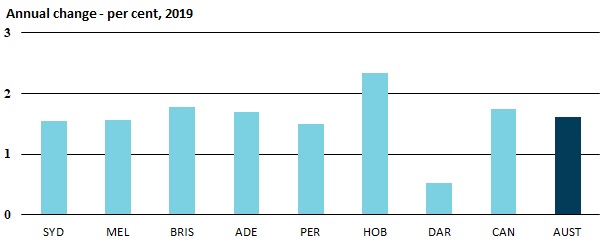
| |
2015 |
2016 |
2017 |
2018 |
2019 |
| |
|
|
|
|
|
| Consumer price index (a) |
|
|
|
|
|
| Sydney |
108.3 |
109.8 |
112.2 |
114.4 |
116.2 |
| Melbourne |
107.4 |
109.0 |
111.4 |
113.9 |
115.7 |
| Brisbane |
107.7 |
109.4 |
111.3 |
113.2 |
115.2 |
| Adelaide |
106.9 |
107.9 |
110.0 |
112.3 |
114.2 |
| Perth |
107.9 |
108.4 |
109.4 |
110.6 |
112.2 |
| Hobart |
105.6 |
107.0 |
109.3 |
112.1 |
114.7 |
| Darwin |
108.6 |
108.4 |
109.1 |
110.4 |
111.0 |
| Canberra |
105.7 |
107.0 |
109.3 |
112.1 |
114.0 |
Weighted average eight
capital cities |
107.7 |
109.1 |
111.2 |
113.3 |
115.1 |
| |
|
|
|
|
|
| Annual change – per cent (b) |
|
|
|
|
| Sydney |
1.9 |
1.4 |
2.2 |
1.9 |
1.6 |
| Melbourne |
1.4 |
1.5 |
2.3 |
2.2 |
1.6 |
| Brisbane |
1.5 |
1.6 |
1.8 |
1.7 |
1.8 |
| Adelaide |
1.1 |
1.0 |
1.9 |
2.1 |
1.7 |
| Perth |
1.3 |
0.5 |
0.9 |
1.1 |
1.5 |
| Hobart |
1.1 |
1.3 |
2.2 |
2.5 |
2.3 |
| Darwin |
0.5 |
-0.2 |
0.6 |
1.2 |
0.5 |
| Canberra |
0.6 |
1.2 |
2.2 |
2.5 |
1.7 |
Weighted average eight
capital cities |
1.5 |
1.3 |
1.9 |
1.9 |
1.6 |
| |
|
|
|
|
|
| |
|
|
|
|
|
| (a) Annual average of quarterly data; base year for CPI is
2011-12. |
| (b) Change in the annual averages of table above. |
| Source:
ABS, Consumer Price Index, cat. no. 6401.0, December 2019 |
Chapter 3: State Accounts
3.1
Gross state product
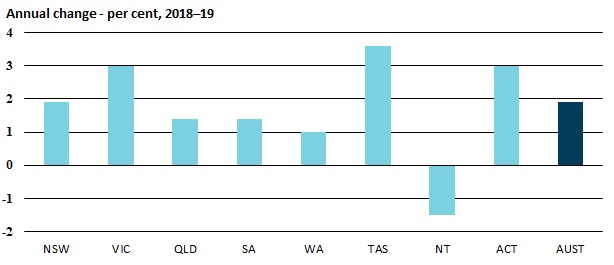
| |
2014-15 |
2015-16 |
2016-17 |
2017-18 |
2018-19 |
| |
|
|
|
|
|
| Gross state product, chain volume measures – $ million |
| New South Wales |
549 534 |
570 349 |
588 454 |
603 143 |
614 409 |
| Victoria |
389 391 |
402 564 |
418 885 |
432 993 |
446 079 |
| Queensland |
323 849 |
331 726 |
339 652 |
352 248 |
357 044 |
| South Australia |
102 333 |
102 602 |
104 125 |
106 477 |
107 990 |
| Western Australia |
253 346 |
256 383 |
251 941 |
258 120 |
260 640 |
| Tasmania |
28 865 |
29 364 |
29 685 |
30 710 |
31 819 |
| Northern Territory |
25 105 |
25 601 |
25 977 |
26 501 |
26 109 |
| Australian Capital Territory |
35 681 |
37 062 |
38 280 |
39 686 |
40 879 |
| Australia |
1 708 151 |
1 755 478 |
1 797 041 |
1 849 880 |
1 884 969 |
| |
|
|
|
|
|
| Annual change – per cent |
|
|
|
|
|
| New South Wales |
2.6 |
3.8 |
3.2 |
2.5 |
1.9 |
| Victoria |
2.8 |
3.4 |
4.1 |
3.4 |
3.0 |
| Queensland |
1.0 |
2.4 |
2.4 |
3.7 |
1.4 |
| South Australia |
0.9 |
0.3 |
1.5 |
2.3 |
1.4 |
| Western Australia |
2.5 |
1.2 |
-1.7 |
2.5 |
1.0 |
| Tasmania |
1.1 |
1.7 |
1.1 |
3.5 |
3.6 |
| Northern Territory |
2.5 |
2.0 |
1.5 |
2.0 |
-1.5 |
| Australian Capital Territory |
2.3 |
3.9 |
3.3 |
3.7 |
3.0 |
| Australia |
2.2 |
2.8 |
2.4 |
2.9 |
1.9 |
| |
|
|
|
|
|
| |
|
|
|
|
|
| Note:
Gross state product is only published on a financial year basis. 2019-20
figures will be released in November 2020. |
| Source: ABS, Australian National Accounts: State Accounts,
cat. no. 5220.0, 2018-19 |
3.2 Gross state product per
capita
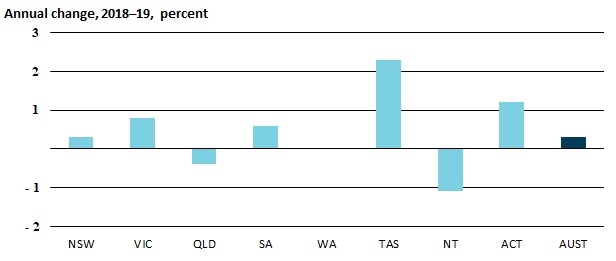
| |
2014-15 |
2015-16 |
2016-17 |
2017-18 |
2018-19 |
| |
|
|
|
|
|
| Gross state product per capita, chain volume measures (a) – $ |
|
|
| New South Wales |
72 669 |
74 347 |
75 426 |
76 133 |
76 361 |
| Victoria |
65 361 |
66 069 |
67 077 |
67 793 |
68 350 |
| Queensland |
68 218 |
69 039 |
69 546 |
70 976 |
70 662 |
| South Australia |
60 441 |
60 144 |
60 629 |
61 613 |
61 965 |
| Western Australia |
100 191 |
100 631 |
98 272 |
99 955 |
100 003 |
| Tasmania |
56 153 |
56 941 |
57 108 |
58 493 |
59 863 |
| Northern Territory |
103 420 |
104 885 |
105 520 |
107 352 |
106 196 |
| Australian Capital Territory |
91 026 |
92 916 |
93 941 |
95 345 |
96 456 |
| Australia |
72 265 |
73 201 |
73 694 |
74 680 |
74 873 |
| |
|
|
|
|
|
| Annual change – per cent |
|
|
|
|
|
| New South Wales |
1.2 |
2.3 |
1.5 |
0.9 |
0.3 |
| Victoria |
0.6 |
1.1 |
1.5 |
1.1 |
0.8 |
| Queensland |
-0.3 |
1.2 |
0.7 |
2.1 |
-0.4 |
| South Australia |
0.0 |
-0.5 |
0.8 |
1.6 |
0.6 |
| Western Australia |
1.4 |
0.4 |
-2.3 |
1.7 |
0.0 |
| Tasmania |
0.9 |
1.4 |
0.3 |
2.4 |
2.3 |
| Northern Territory |
2.3 |
1.4 |
0.6 |
1.7 |
-1.1 |
| Australian Capital Territory |
0.8 |
2.1 |
1.1 |
1.5 |
1.2 |
| Australia |
0.7 |
1.3 |
0.7 |
1.3 |
0.3 |
| |
|
|
|
|
|
| |
|
|
|
|
|
| Note:
Gross state product is only published on a financial year basis. 2019-20
figures will be released in November 2020. |
| Source: ABS, Australian National Accounts: State Accounts,
cat. no. 5220.0, 2018-19 |
3.3
Labour productivity
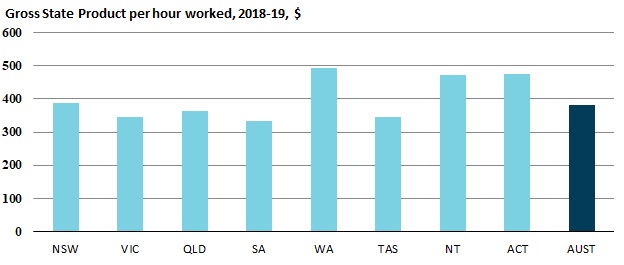
| |
2014-15 |
2015-16 |
2016-17 |
2017-18 |
2018-19 |
| |
|
|
|
|
|
| Gross State Product per hour worked, $ |
|
|
|
| New South Wales |
389.5 |
381.1 |
399.6 |
397.5 |
386.1 |
| Victoria |
350.5 |
344.2 |
349.7 |
356.3 |
346.3 |
| Queensland |
351.5 |
352.5 |
367.6 |
368.0 |
362.8 |
| South Australia |
335.8 |
335.9 |
341.3 |
343.4 |
334.5 |
| Western Australia |
481.4 |
493.5 |
500.4 |
504.1 |
491.7 |
| Tasmania |
330.3 |
328.4 |
335.4 |
340.9 |
346.5 |
| Northern Territory |
447.5 |
442.0 |
451.1 |
467.5 |
470.5 |
| Australian Capital Territory |
450.3 |
451.4 |
468.3 |
466.8 |
474.0 |
| Australia |
379.8 |
376.6 |
388.1 |
389.9 |
380.8 |
| |
|
|
|
|
|
| Annual change – per cent |
|
|
|
|
|
| New South Wales |
3.1 |
-2.2 |
4.9 |
-0.5 |
-2.9 |
| Victoria |
2.9 |
-1.8 |
1.6 |
1.9 |
-2.8 |
| Queensland |
2.8 |
0.3 |
4.3 |
0.1 |
-1.4 |
| South Australia |
1.7 |
0.0 |
1.6 |
0.6 |
-2.6 |
| Western Australia |
2.5 |
2.5 |
1.4 |
0.7 |
-2.5 |
| Tasmania |
-0.4 |
-0.6 |
2.1 |
1.6 |
1.7 |
| Northern Territory |
3.4 |
-1.2 |
2.0 |
3.6 |
0.6 |
| Australian Capital Territory |
2.9 |
0.3 |
3.7 |
-0.3 |
1.5 |
| Australia |
2.8 |
-0.9 |
3.1 |
0.5 |
-2.3 |
| |
|
|
|
|
|
| |
|
|
|
|
|
| (a) Gross state product (chain volume measures) per hour worked,
all sectors (i.e. market and non-market sectors). |
| Note:
Gross state product is only published on a financial year basis. |
| Source:
ABS, Australian National Accounts: State Accounts, cat. no. 5220.0,
2018-19; ABS, Labour Force, Detailed, cat. no. 6291.0.55.001, February
2020 |
Chapter 4:
Business Conditions
4.1 Value of retail sales
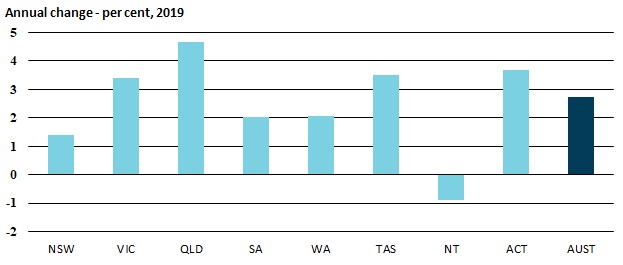
| |
2015 |
2016 |
2017 |
2018 |
2019 |
| |
|
|
|
|
|
| Value – $ million |
|
|
|
|
|
| New South Wales |
93 698 |
97 953 |
100 640 |
103 408 |
104 842 |
| Victoria |
73 320 |
76 508 |
79 270 |
83 392 |
86 222 |
| Queensland |
59 585 |
61 284 |
62 074 |
63 469 |
66 423 |
| South Australia |
19 017 |
19 813 |
20 511 |
21 035 |
21 465 |
| Western Australia |
33 687 |
34 052 |
34 010 |
33 966 |
34 670 |
| Tasmania |
5 760 |
6 042 |
6 205 |
6 457 |
6 684 |
| Northern Territory |
3 092 |
3 124 |
3 125 |
3 145 |
3 117 |
| Australian Capital Territory |
5 233 |
5 589 |
5 729 |
5 925 |
6 142 |
| Australia |
293 391 |
304 365 |
311 565 |
320 798 |
329 563 |
| |
|
|
|
|
|
| Annual change – per cent |
|
|
|
|
|
| New South Wales |
5.5 |
4.5 |
2.7 |
2.7 |
1.4 |
| Victoria |
5.3 |
4.3 |
3.6 |
5.2 |
3.4 |
| Queensland |
3.3 |
2.9 |
1.3 |
2.2 |
4.7 |
| South Australia |
4.6 |
4.2 |
3.5 |
2.6 |
2.0 |
| Western Australia |
2.7 |
1.1 |
-0.1 |
-0.1 |
2.1 |
| Tasmania |
3.8 |
4.9 |
2.7 |
4.1 |
3.5 |
| Northern Territory |
0.4 |
1.0 |
0.1 |
0.6 |
-0.9 |
| Australian Capital Territory |
4.6 |
6.8 |
2.5 |
3.4 |
3.7 |
| Australia |
4.5 |
3.7 |
2.4 |
3.0 |
2.7 |
| |
|
|
|
|
|
| |
|
|
|
|
|
| |
|
|
|
|
|
| Source:
ABS, Retail Trade Australia, cat. no. 8501.0, February 2020 |
4.2 Dwelling approvals
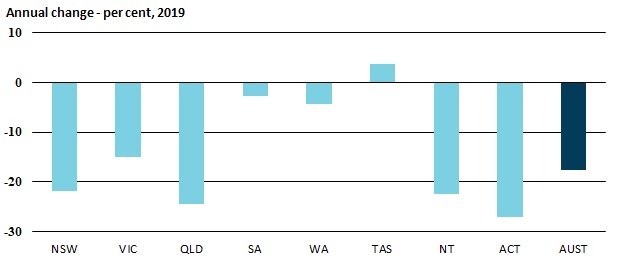
| |
2015 |
2016 |
2017 |
2018 |
2019 |
| |
|
|
|
|
|
| Number (a) |
|
|
|
|
|
| New South Wales |
71 532 |
74 680 |
72 456 |
64 700 |
50 611 |
| Victoria |
68 669 |
68 756 |
70 375 |
67 972 |
57 749 |
| Queensland |
50 856 |
47 781 |
42 513 |
39 857 |
30 115 |
| South Australia |
11 370 |
12 123 |
12 257 |
11 894 |
11 560 |
| Western Australia |
28 660 |
21 913 |
19 564 |
15 890 |
15 199 |
| Tasmania |
2 793 |
2 171 |
2 688 |
3 043 |
3 157 |
| Northern Territory |
1 666 |
1 278 |
813 |
728 |
565 |
| Australian Capital Territory |
4 189 |
6 158 |
4 348 |
7 160 |
5 221 |
| Australia |
239 735 |
234 860 |
225 014 |
211 244 |
174 177 |
| |
|
|
|
|
|
| Annual change – per cent |
|
|
|
|
|
| New South Wales |
28.7 |
4.4 |
-3.0 |
-10.7 |
-21.8 |
| Victoria |
12.8 |
0.1 |
2.4 |
-3.4 |
-15.0 |
| Queensland |
26.6 |
-6.0 |
-11.0 |
-6.2 |
-24.4 |
| South Australia |
-3.5 |
6.6 |
1.1 |
-3.0 |
-2.8 |
| Western Australia |
-13.4 |
-23.5 |
-10.7 |
-18.8 |
-4.3 |
| Tasmania |
9.5 |
-22.3 |
23.8 |
13.2 |
3.7 |
| Northern Territory |
-16.7 |
-23.3 |
-36.4 |
-10.5 |
-22.4 |
| Australian Capital Territory |
6.4 |
47.0 |
-29.4 |
64.7 |
-27.1 |
| Australia |
14.2 |
-2.0 |
-4.2 |
-6.1 |
-17.5 |
| |
|
|
|
|
|
| |
|
|
|
|
|
| (a) Houses and other dwellings (e.g. flats) intended for
long-term residential use; includes both private and public sector dwellings. |
4.3 Business investment
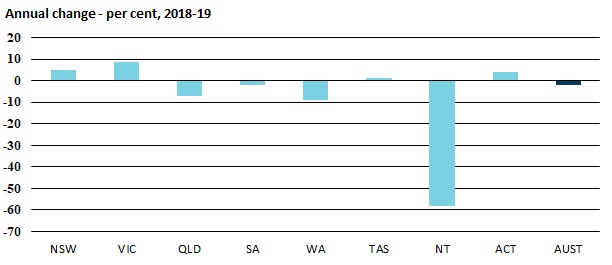
| |
2014-15 |
2015-16 |
2016-17 |
2017-18 |
2018-19 |
| |
|
|
|
|
|
| Chain volume measures (a) – $ million |
|
|
|
|
| New South Wales |
54 387 |
55 255 |
55 078 |
61 951 |
64 911 |
| Victoria |
41 442 |
41 511 |
42 671 |
47 184 |
51 178 |
| Queensland |
54 007 |
40 305 |
40 406 |
45 126 |
41 923 |
| South Australia |
12 582 |
11 163 |
8 883 |
12 885 |
12 598 |
| Western Australia |
66 079 |
53 095 |
37 759 |
37 497 |
34 092 |
| Tasmania |
2 506 |
2 333 |
2 424 |
2 991 |
3 033 |
| Northern Territory |
9 337 |
7 095 |
9 260 |
7 736 |
3 236 |
| Australian Capital Territory |
2 289 |
2 345 |
2 555 |
2 658 |
2 759 |
| Australia |
242 313 |
213 014 |
198 991 |
218 027 |
213 730 |
| |
|
|
|
|
|
| Annual change – per cent |
|
|
|
|
|
| New South Wales |
2.7 |
1.6 |
-0.3 |
12.5 |
4.8 |
| Victoria |
7.2 |
0.2 |
2.8 |
10.6 |
8.5 |
| Queensland |
-23.4 |
-25.4 |
0.3 |
11.7 |
-7.1 |
| South Australia |
2.7 |
-11.3 |
-20.4 |
45.1 |
-2.2 |
| Western Australia |
-9.6 |
-19.6 |
-28.9 |
-0.7 |
-9.1 |
| Tasmania |
6.0 |
-6.9 |
3.9 |
23.4 |
1.4 |
| Northern Territory |
-11.5 |
-24.0 |
30.5 |
-16.5 |
-58.2 |
| Australian Capital Territory |
2.6 |
2.4 |
9.0 |
4.0 |
3.8 |
| Australia |
-7.5 |
-12.1 |
-6.6 |
9.6 |
-2.0 |
| |
|
|
|
|
|
| |
|
|
|
|
|
| (a) Private business gross fixed capital formation for other
buildings and structures, machinery and equipment, livestock and intangible
fixed assets. |
| Note: National account data is only available for financial
years. 2019-20 data will be available in November 2020. |
| Source:
Australian National Accounts: State Accounts, cat. no. 5220.0, 2018-19 |
Chapter
5: Housing
5.1 Lending for owner occupied
housing
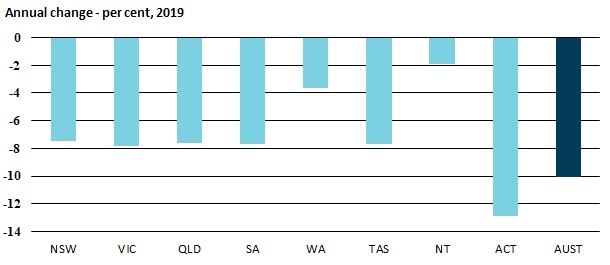
| |
2015 |
2016 |
2017 |
2018 |
2019 |
| |
|
|
|
|
|
| Value (a) – $ million |
|
|
|
|
|
| New South Wales |
47 876 |
49 873 |
56 189 |
53 304 |
49 142 |
| Victoria |
40 502 |
43 011 |
49 925 |
49 622 |
45 843 |
| Queensland |
27 702 |
29 099 |
30 699 |
29 427 |
27 157 |
| South Australia |
8 441 |
8 929 |
9 255 |
9 283 |
8 948 |
| Western Australia |
18 091 |
15 927 |
15 506 |
13 882 |
12 814 |
| Tasmania |
1 948 |
2 145 |
2 421 |
2 642 |
2 591 |
| Northern Territory |
1 178 |
1 021 |
967 |
876 |
763 |
| Australian Capital Territory |
3 219 |
3 378 |
4 051 |
4 194 |
3 772 |
| Australia |
148 957 |
153 383 |
169 013 |
163 229 |
151 030 |
| |
|
|
|
|
|
| Annual change – per cent |
|
|
|
|
|
| New South Wales |
10.3 |
3.0 |
10.2 |
-3.4 |
-7.5 |
| Victoria |
24.3 |
4.2 |
12.7 |
-5.1 |
-7.8 |
| Queensland |
16.8 |
6.2 |
16.1 |
-0.6 |
-7.6 |
| South Australia |
4.1 |
5.0 |
5.5 |
-4.1 |
-7.7 |
| Western Australia |
3.8 |
5.8 |
3.6 |
0.3 |
-3.6 |
| Tasmania |
-12.6 |
-12.0 |
-2.6 |
-10.5 |
-7.7 |
| Northern Territory |
-3.6 |
10.1 |
12.9 |
9.1 |
-1.9 |
| Australian Capital Territory |
-19.8 |
-13.3 |
-5.4 |
-9.4 |
-12.9 |
| Australia |
13.6 |
4.9 |
19.9 |
3.5 |
-10.1 |
| |
|
|
|
|
|
| |
|
|
|
|
|
| (a) Lending commitments by all types of lenders for the
construction and purchase of new or established owner occupied dwellings excluding
refinancing. |
| Source:
ABS, Lending Indicators, Cat. No. 5601.0, February 2020 |
Chapter
6: Public Sector Finances
6.1
General government sector fiscal balance
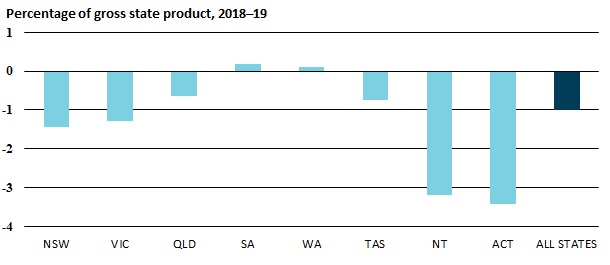
| |
2014-15 |
2015-16 |
2016-17 |
2017-18 |
2018-19 |
| |
|
|
|
|
|
| General government sector fiscal balance (a) – $ million |
|
|
|
| New South Wales |
612 |
71 |
- 503 |
-3 061 |
-8 992 |
| Victoria |
- 423 |
55 |
-2 026 |
-6 164 |
-5 909 |
| Queensland |
- 659 |
- 478 |
1 332 |
- 108 |
-2 358 |
| South Australia |
- 122 |
94 |
-2 324 |
- 889 |
192 |
| Western Australia |
-1 914 |
-3 442 |
-3 941 |
-1 981 |
281 |
| Tasmania |
- 55 |
45 |
680 |
- 81 |
- 243 |
| Northern Territory |
- 121 |
- 22 |
- 469 |
- 703 |
- 876 |
| Australian Capital Territory |
- 912 |
- 627 |
- 209 |
- 238 |
-1 429 |
| Total (b) |
-3 595 |
-4 317 |
-7 467 |
-13 226 |
-19 365 |
| |
|
|
|
|
|
| General government sector fiscal balance – percentage of gross
state product |
|
|
| New South Wales |
0.1 |
0.0 |
-0.1 |
-0.5 |
-1.4 |
| Victoria |
-0.1 |
0.0 |
-0.5 |
-1.4 |
-1.3 |
| Queensland |
-0.2 |
-0.2 |
0.4 |
0.0 |
-0.6 |
| South Australia |
-0.1 |
0.1 |
-2.3 |
-0.8 |
0.2 |
| Western Australia |
-0.8 |
-1.4 |
-1.6 |
-0.8 |
0.1 |
| Tasmania |
-0.2 |
0.2 |
2.3 |
-0.3 |
-0.7 |
| Northern Territory |
-0.5 |
-0.1 |
-1.8 |
-2.7 |
-3.2 |
| Australian Capital Territory |
-2.6 |
-1.7 |
-0.6 |
-0.6 |
-3.4 |
| Total (c) |
-0.2 |
-0.3 |
-0.4 |
-0.7 |
-1.0 |
| |
|
|
|
|
|
| |
|
|
|
|
|
| (a) The financing requirement of government. A positive sign, or
fiscal surplus, indicates a net lending position; a negative sign, or fiscal
deficit, indicates a net borrowing position. |
| (b) The sum of all state and territory jurisdictions may not
agree with the total, due to transfers between jurisdictions. |
| (c) Total or aggregate fiscal balance for all jurisdictions is
expressed as a percentage of gross state product. |
| Sources:
ABS, Government Finance Statistics, cat. no. 5512.0, 2018-19 |
6.2 State and local government
taxation revenue
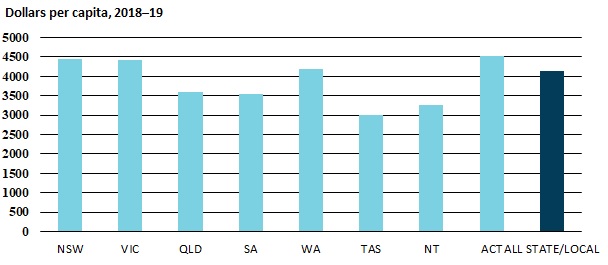
| |
2014-15 |
2015-16 |
2016-17 |
2017-18 |
2018-19 |
| |
|
|
|
|
|
| General government sector taxation revenue – $ million |
|
|
|
| New South Wales |
30 350 |
33 426 |
35 150 |
35 661 |
36 062 |
| Victoria |
22 904 |
24 776 |
26 533 |
28 254 |
29 191 |
| Queensland |
16 043 |
16 168 |
16 708 |
17 195 |
18 293 |
| South Australia |
5 765 |
5 871 |
5 935 |
6 130 |
6 207 |
| Western Australia |
10 784 |
11 150 |
10 757 |
10 839 |
11 005 |
| Tasmania |
1 360 |
1 428 |
1 477 |
1 547 |
1 604 |
| Northern Territory |
828 |
729 |
737 |
770 |
801 |
| Australian Capital Territory |
1 377 |
1 568 |
1 695 |
1 718 |
1 934 |
| Total (a) |
89 411 |
95 115 |
98 992 |
102 113 |
105 098 |
| |
|
|
|
|
|
| General government sector taxation revenue per capita - $ |
|
|
|
| New South Wales |
3 985 |
4 323 |
4 467 |
4 469 |
4 458 |
| Victoria |
3 803 |
4 013 |
4 197 |
4 372 |
4 426 |
| Queensland |
3 358 |
3 337 |
3 391 |
3 433 |
3 591 |
| South Australia |
3 390 |
3 428 |
3 443 |
3 530 |
3 543 |
| Western Australia |
4 245 |
4 362 |
4 179 |
4 178 |
4 198 |
| Tasmania |
2 640 |
2 759 |
2 827 |
2 928 |
3 001 |
| Northern Territory |
3 384 |
2 967 |
2 978 |
3 117 |
3 257 |
| Australian Capital Territory |
3 479 |
3 890 |
4 114 |
4 087 |
4 532 |
| Total (b) |
3 754 |
3 932 |
4 024 |
4 087 |
4 143 |
| |
|
|
|
|
|
| |
|
|
|
|
|
| (a) Total is the sum of taxation revenue from all state and
local government sources, not taxation revenue for Australia as it excludes
Commonwealth taxation. |
| (b) Total is the quotient of total taxation revenue (a) and the
population of Australia. This is not equivalent to the taxation revenue per
capita for Australia as Commonwealth taxation is excluded. |
| Source:
ABS, Taxation Revenue, cat. no. 5506.0, 2018-19 |
Chapter
7: Exports
7.1 Merchandise exports
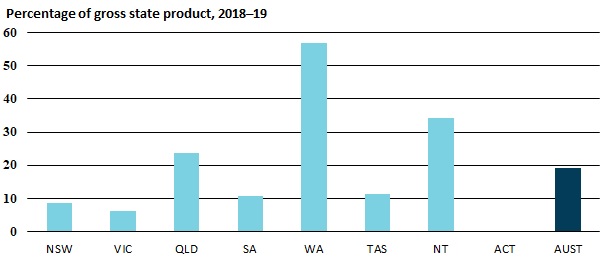
| |
2014-15 |
2015-16 |
2016-17 |
2017-18 |
2018-19 |
| |
|
|
|
|
|
| Merchandise exports (a) – $ million |
|
|
|
|
| New South Wales |
37 032 |
36 193 |
44 078 |
47 597 |
53 820 |
| Victoria |
23 609 |
23 323 |
24 729 |
26 824 |
28 148 |
| Queensland |
46 488 |
47 867 |
66 485 |
74 263 |
87 249 |
| South Australia |
11 322 |
11 567 |
11 432 |
12 042 |
11 716 |
| Western Australia |
110 775 |
99 635 |
120 398 |
129 698 |
162 318 |
| Tasmania |
2 542 |
2 848 |
2 758 |
3 675 |
3 658 |
| Northern Territory |
6 177 |
4 701 |
4 898 |
5 721 |
9 412 |
| Australian Capital Territory |
6 |
14 |
21 |
23 |
17 |
| Australia (b) |
254 552 |
243 423 |
290 880 |
314 479 |
372 621 |
| |
|
|
|
|
|
| Merchandise exports – percentage of gross state product |
|
|
|
| New South Wales |
7.1 |
6.7 |
7.6 |
7.9 |
8.6 |
| Victoria |
6.3 |
6.0 |
6.0 |
6.2 |
6.2 |
| Queensland |
15.7 |
15.8 |
20.1 |
21.1 |
23.6 |
| South Australia |
11.4 |
11.6 |
11.1 |
11.3 |
10.6 |
| Western Australia |
44.0 |
41.5 |
48.3 |
50.2 |
56.8 |
| Tasmania |
9.2 |
10.1 |
9.4 |
12.0 |
11.2 |
| Northern Territory |
25.3 |
19.3 |
19.2 |
21.6 |
34.2 |
| Australian Capital Territory |
0.0 |
0.0 |
0.1 |
0.1 |
0.0 |
| Australia (b) |
15.7 |
14.7 |
16.5 |
17.0 |
19.1 |
| |
|
|
|
|
|
| |
|
|
|
|
|
| (a) State in which the final stage of manufacture or production
occurs. FOB value. |
| (b) Includes re-exports and state figures not available for
publication. Australian total, therefore, may not equal sum of states and
territories. |
| Note: This table is based on national accounts data. |
| Sources:
ABS, International Trade in Goods and Services, cat. no. 5368.0; ABS, Australian
National Accounts: State Accounts, cat. no. 5220.0, 2018-19 |
Chapter
8: Social Statistics
8.1 Population
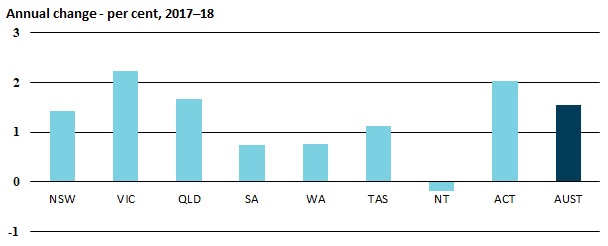
| |
2012-13 |
2013-14 |
2014-15 |
2015-16 |
2016-17 |
| |
|
|
|
|
|
| Population (a) – '000 |
|
|
|
|
|
| New South Wales |
7 508.4 |
7 616.2 |
7 732.9 |
7 867.1 |
7 979.6 |
| Victoria |
5 894.9 |
6 022.3 |
6 173.2 |
6 320.3 |
6 460.5 |
| Queensland |
4 719.7 |
4 777.7 |
4 845.2 |
4 928.4 |
5 010.4 |
| South Australia |
1 686.9 |
1 700.7 |
1 712.8 |
1 723.7 |
1 736.4 |
| Western Australia |
2 517.6 |
2 540.7 |
2 556.0 |
2 574.8 |
2 594.2 |
| Tasmania |
513.6 |
515.1 |
517.5 |
522.3 |
528.1 |
| Northern Territory |
242.9 |
244.7 |
245.7 |
247.7 |
247.2 |
| Australian Capital Territory |
388.8 |
395.8 |
403.1 |
412.0 |
420.4 |
| Australia |
23 475.7 |
23 816.0 |
24 190.9 |
24 600.8 |
24 981.3 |
| |
|
|
|
|
|
| Annual change – per cent |
|
|
|
|
|
| New South Wales |
1.4 |
1.4 |
1.5 |
1.7 |
1.4 |
| Victoria |
2.1 |
2.2 |
2.5 |
2.4 |
2.2 |
| Queensland |
1.4 |
1.2 |
1.4 |
1.7 |
1.7 |
| South Australia |
0.9 |
0.8 |
0.7 |
0.6 |
0.7 |
| Western Australia |
1.2 |
0.9 |
0.6 |
0.7 |
0.8 |
| Tasmania |
0.3 |
0.3 |
0.5 |
0.9 |
1.1 |
| Northern Territory |
0.5 |
0.7 |
0.4 |
0.8 |
-0.2 |
| Australian Capital Territory |
1.4 |
1.8 |
1.8 |
2.2 |
2.0 |
| Australia |
1.5 |
1.4 |
1.6 |
1.7 |
1.5 |
| |
|
|
|
|
|
| |
|
|
|
|
|
| (a) Estimated resident population numbers are as at June of each
year. |
| Source:
ABS, Australian Demographic Statistics, cat. no. 3101.0, March 2018 |
8.2 Capped apparent school
retention rates
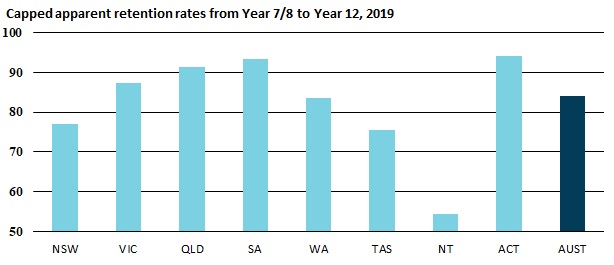
| |
2015 |
2016 |
2017 |
2018 |
2019 |
| |
|
|
|
|
|
| Apparent retention rates from Year 10 to Year 12 (a) |
|
|
|
| New South Wales |
77.5 |
77.2 |
77.5 |
76.3 |
75.8 |
| Victoria |
84.8 |
85.0 |
85.3 |
84.7 |
83.3 |
| Queensland |
86.7 |
87.3 |
87.8 |
87.8 |
88.1 |
| South Australia |
92.2 |
94.5 |
91.7 |
90.8 |
89.1 |
| Western Australia |
81.0 |
80.5 |
83.1 |
85.0 |
85.5 |
| Tasmania |
72.1 |
70.8 |
71.5 |
73.2 |
74.3 |
| Northern Territory |
63.8 |
64.2 |
70.2 |
65.1 |
64.1 |
| Australian Capital Territory |
95.1 |
92.2 |
92.1 |
90.0 |
89.8 |
| Australia |
82.7 |
82.9 |
83.3 |
82.8 |
82.0 |
| |
|
|
|
|
|
| Apparent retention rates from Year 7/8 to Year 12 (b) |
|
|
|
| New South Wales |
78.2 |
78.4 |
78.9 |
77.8 |
77.1 |
| Victoria |
86.4 |
87.9 |
88.5 |
88.7 |
87.4 |
| Queensland |
88.4 |
88.6 |
89.1 |
89.2 |
91.3 |
| South Australia |
95.7 |
97.5 |
94.7 |
94.6 |
93.4 |
| Western Australia |
82.8 |
80.3 |
82.3 |
83.3 |
83.5 |
| Tasmania |
71.7 |
70.4 |
71.5 |
74.0 |
75.5 |
| Northern Territory |
53.7 |
56.7 |
58.6 |
52.5 |
54.3 |
| Australian Capital Territory |
96.6 |
94.0 |
94.8 |
92.8 |
94.0 |
| Australia |
84.0 |
84.3 |
84.8 |
84.5 |
84.0 |
| |
|
|
|
|
|
| |
|
|
|
|
|
| (a) The number of full-time school students in Year 12 expressed
as a percentage of the corresponding group at the commencement of their Year
10 schooling. |
| (b) The number of full-time school students in Year 12 expressed
as a percentage of the corresponding group at the commencement of their
secondary schooling. |
| Source:
ABS, Schools, cat. no. 4221.0, 2019 |
8.3 General practice bulk billing
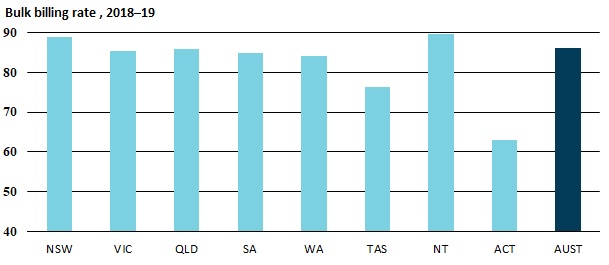
| |
2014-15 |
2015-16 |
2016-17 |
2017-18 |
2018-19 |
| |
|
|
|
|
|
| General practice bulk billing rate (a) – per cent |
|
|
|
| New South Wales |
88.2 |
88.6 |
88.7 |
88.9 |
88.9 |
| Victoria |
84.0 |
84.8 |
85.2 |
85.4 |
85.5 |
| Queensland |
83.7 |
84.5 |
85.4 |
85.9 |
86.0 |
| South Australia |
83.3 |
84.0 |
84.8 |
84.9 |
85.2 |
| Western Australia |
77.8 |
80.1 |
82.4 |
84.0 |
85.3 |
| Tasmania |
77.3 |
76.7 |
76.5 |
76.4 |
76.4 |
| Northern Territory |
84.5 |
87.4 |
88.9 |
89.7 |
89.6 |
| Australian Capital Territory |
57.9 |
60.0 |
61.8 |
63.0 |
64.1 |
| Australia |
84.3 |
85.1 |
85.7 |
86.1 |
86.2 |
| |
|
|
|
|
|
| |
|
|
|
|
|
| (a) Proportion of general practitioner attendances (excluding
practice nurse), enhanced primary care and other non-referred attendances
that are bulk billed. |
| Note: This data is only published on a financial year basis. |
| Source:
Department of Health and Ageing, Annual Medicare Statistics, 2018-19 |
Glossary
Apparent
school retention rate. The number of full-time school students in a designated
level/year of education expressed as a percentage of their respective cohort
group (which is either at the commencement of their secondary schooling or Year
10). For a discussion of
‘apparent’ retention rates compared to actual retention rates, see the ABS
source publication, Schools, Australia, 2014 (cat. no. 4221.0)
explanatory notes.
Average
weekly earnings. Average
gross (before tax) earnings of employees.
Average
weekly ordinary time earnings. Weekly earnings attributed to award, standard or agreed hours of work.
Business
investment. Private gross
fixed capital formation for machinery and equipment; non-dwelling construction;
livestock; and intangible fixed assets.
Consumer
price index. A measure of
change in the price of a basket of goods and services from a base period.
Changes in the consumer price index are the most commonly used measures of
inflation.
Employed
persons. Persons aged 15
and over who, during a period of one week, worked for one hour or more for pay
or worked for one hour or more without pay in a family business or on a family
farm.
General
government sector. Government
departments and other entities that provide largely non-market public services
and are funded mainly through taxes and other compulsory levies.
General
government sector net debt. Selected
liabilities (deposits held plus proceeds from advances plus borrowing) minus
selected assets (cash and deposits plus investments plus advances outstanding)
of the general government sector.
General
government sector fiscal balance. The financing requirement of the general government sector. A positive
sign, or fiscal surplus, indicates a net lending position; a negative sign, or
fiscal deficit, indicates a net borrowing position.
General
practice bulk billing rate.
The percentage of general practitioner attendances (excluding practice nurse)
that are bulk billed.
Gross
domestic product. The
total market value of goods and services produced within Australia, after
deducting the cost of goods and services used up in the process of production
but before deducting for depreciation.
Gross
state product. Equivalent
to gross domestic product except it refers to production within a state or
territory rather than to the nation as a whole.
Gross
state product—chain volume measures. Also known as real gross state product, this is a
measure used to indicate change in the actual quantity of goods and services
produced within a state or territory.
Gross
state product per capita. The
ratio of the chain volume measure of gross state product to an estimate of the
resident population in the state or territory.
Job
vacancy. A job available
for immediate filling and for which recruitment action has been taken.
Job
vacancy rate. The number
of job vacancies expressed as a percentage of the number of employee jobs plus
the number of job vacancies.
Labour
force. The employed plus
the unemployed.
Labour
force participation rate.
The number of persons in the labour force expressed as a percentage of the
civilian population aged 15 years and over.
Labour
productivity. Gross state
product (chain volume measures) per hour worked, all sectors (that is, market
and non-market sectors).
Male
total average weekly earnings. Weekly ordinary time earnings plus weekly overtime earnings of all
male employees. This measure of earnings is used in the process of benchmarking
pensions.
Real
average weekly earnings.
Average weekly earnings adjusted for inflation as measured by the Consumer
Price Index.
Turnover. Includes retail sales; wholesale sales;
takings from repairs, meals and hiring of goods; commissions from agency
activity; and net takings from gaming machines. Turnover includes the Goods and
Services Tax.
Unemployed
persons. Persons aged 15
and over who, during a period of one week, were not employed but had actively
looked for work in the previous four weeks and were available to start work.
Unemployment
rate. The number of
unemployed persons expressed as a percentage of the labour force.
Wage
price index. A measure of
change in the price of labour (that is, wages, salaries and overtime)
unaffected by changes in the quality or quantity of work performed.
For copyright reasons some linked items are only available to members of Parliament.
© Commonwealth of Australia

Creative Commons
With the exception of the Commonwealth Coat of Arms, and to the extent that copyright subsists in a third party, this publication, its logo and front page design are licensed under a Creative Commons Attribution-NonCommercial-NoDerivs 3.0 Australia licence.
In essence, you are free to copy and communicate this work in its current form for all non-commercial purposes, as long as you attribute the work to the author and abide by the other licence terms. The work cannot be adapted or modified in any way. Content from this publication should be attributed in the following way: Author(s), Title of publication, Series Name and No, Publisher, Date.
To the extent that copyright subsists in third party quotes it remains with the original owner and permission may be required to reuse the material.
Inquiries regarding the licence and any use of the publication are welcome to webmanager@aph.gov.au.
This work has been prepared to support the work of the Australian Parliament using information available at the time of production. The views expressed do not reflect an official position of the Parliamentary Library, nor do they constitute professional legal opinion.
Any concerns or complaints should be directed to the Parliamentary Librarian. Parliamentary Library staff are available to discuss the contents of publications with Senators and Members and their staff. To access this service, clients may contact the author or the Library‘s Central Entry Point for referral.